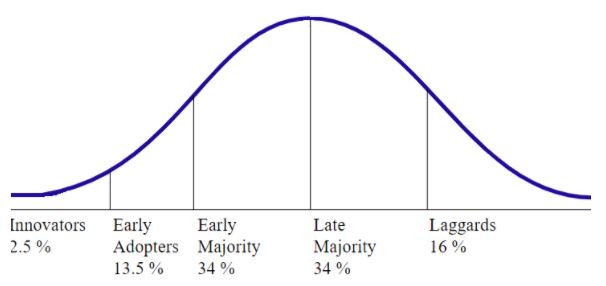

This article is an excerpt from the Shortform book guide to "Purple Cow" by Seth Godin. Shortform has the world's best summaries and analyses of books you should be reading.
Like this article? Sign up for a free trial here .
What is idea diffusion? Why is the most valuable part of the marketing curve the early adopters and not the late majority?
Idea diffusion is a measure of how ideas (and therefore products) spread through a population. It helps you understand why mass marketing strategies no longer work.
Keep reading to learn more about idea diffusion and the marketing curve.
Idea Diffusion: How Products Spread Through a Population
To fully understand why traditional mass marketing strategies don’t work anymore, we need to understand how ideas (and therefore products) spread through a population, or idea diffusion. Geoff Moore’s book Crossing the Chasm proposes a model for how this works.
Moore’s Idea Diffusion Curve

The X-axis (horizontal) of the graph shows different types of consumers, and the Y-axis (vertical) shows roughly how many of each type there are.
The center part of the curve seems like the ideal place to target, and in fact that’s exactly what traditional mass marketing does. Remember the TV-industrial complex: Ads generate profits, which generates more ads. However, the most valuable part of the marketing curve is often the left side: The risk-taking innovators and early adopters who are actively looking for new and better products.
Not only will the risk-takers be more likely to adopt a new product, but they’ll also often be the ones to spend the most money on it. For example, a large bank noticed that only 10% of their customers were using their mobile app every day; however, those customers accounted for 70% of the bank’s deposits.
On top of that, innovators and early adopters will be the ones to spread a new idea to the rest of the curve. This idea diffusion is far more effective (and therefore much more valuable) than targeting the majority with ads that they’ll just ignore.
However, oftentimes innovators and early adopters won’t sell your product very well. They don’t know your product the way you do, and they aren’t trained on the messages you’d want to convey. That’s why a good slogan is key. In the days of mass marketing, a slogan was a way to get your entire message across in just a few seconds during a commercial or ad; nowadays it makes sure that people give their friends the right message about your product.
The early and late majority are usually looking for safety and certainty, and they won’t buy a new product until the risk-taking innovators and early adopters have tried it and vouched for it. Also, many of the early and late majority are the “satisfied customers” mentioned before, the ones who aren’t looking for something new. Not only do you have to convince them that their product is worthwhile, you have to convince them that it’s worth switching from whatever they’re using now.
This is why the leading brand in a market has a huge advantage. People who don’t have time to sort through all the different choices will often just assume that the most recognizable name is the best (or at least good enough for them).
Case Study: Digital Cameras
Digital cameras initially sold very poorly because they were difficult to use and the photo quality wasn’t great. Twenty years ago, the only people you’d see with digital cameras were the tech fanatics who wanted to stay on the cutting edge—that is to say, the innovators and early adopters.
Manufacturers noticed this, and made great strides to improve both the quality and ease of use of their products. With the major problems fixed, digital cameras all but completely replaced film.
This happened because digital cameras were able to successfully move through the marketing curve. Cameras without film were remarkable enough to attract the innovators, and (once the issues were fixed) had distinct advantages over the older film cameras. For example, digital cameras are much more convenient than film since you don’t have to get the pictures developed, and are cheaper in the long run because you don’t have to keep buying new film. These advantages are clear and easily demonstrated, which makes digital cameras easy products for innovators to sell to their friends through idea diffusion.

———End of Preview———
Like what you just read? Read the rest of the world's best book summary and analysis of Seth Godin's "Purple Cow" at Shortform .
Here's what you'll find in our full Purple Cow summary :
- Why you have to be remarkable to succeed
- How to help your business stand out
- How to leverage a single remarkable product for all it's worth






